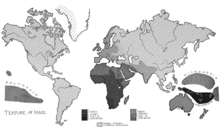Afro
Particularly popular in the African American community of the late 1960s and early 1970s,[3][5] the hairstyle is often shaped and maintained with the assistance of a wide-toothed comb colloquially known as an Afro pick.
The afro became a powerful political symbol which reflected black pride and a rejection of notions of assimilation and integration—not unlike the long and untreated hair sported by the mainly White hippies.
[11] The afro was adopted by both men and women and was a hairstyle that was easier to maintain by oneself, without requiring frequent and sometimes costly visits to the hairstylist as was often experienced by people who chose to braid, straighten or relax their hair.
Due to the kinky pattern prominent in Afro-textured hair, as it grows longer it has a tendency to extend outward from the head, resulting in a domelike hairstyle which is easily molded and sculpted into the desired shape.
[1] Some of the entertainers and sociopolitical figures of the time known for wearing larger afros include political activist Angela Davis, actress Pam Grier, rock musician Jimi Hendrix, singer Miriam Makeba, and the members of the musical groups the Jackson 5 and the Supremes.
Governor Gavin Newsom signed the CROWN Act into law, banning employers and schools from discriminating against hairstyles such as afros, braids, twists, and dreadlocks.
[18] The New York Times in a 1971 article on Harvard University's "hairy" basketball team, wrote that Captain Brian Newmark "hasn't had a haircut since last May, and his friends have suggested his hairdo is a first cousin to the Afro, the style that is popular with blacks.
"[19] Novelist Judith Rossner was described in a Chicago Tribune profile as the "grown-up Wunderkind with an open, oval face framed by a Jewish Afro.
"[20] The Hadendoa Beja of northeastern Africa were nicknamed "Fuzzy-Wuzzies" by British troops during the Mahdist War due to their large and mop-like hairstyles, which they shaped by applying butter or mutton fat.
[21] In Somalia, some young men of the nomadic and sedentary communities would grow their hair long and carefully comb it into rather large bushes, which they would then hold in place with ghee.
[22] This elaborate hairstyle was quite distinct from another coiffure found among other Somalis, who would instead grow long and fluff out their fine, straight hair and place a chewing stick and comb in the center.






